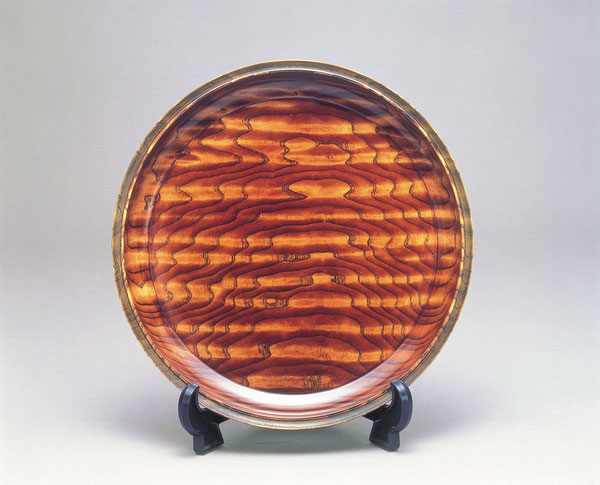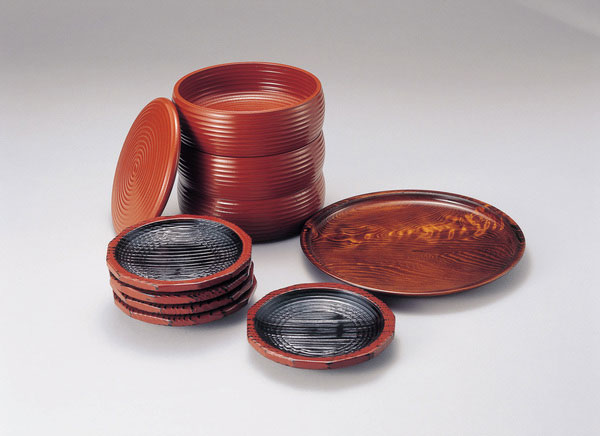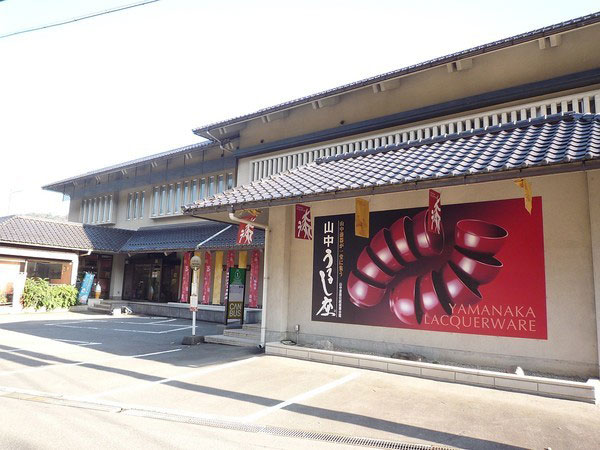 Photo:Ishikawa Prefecture Tourism League
Photo:Ishikawa Prefecture Tourism League
- Lacquerware
- Ishikawa
Yamanaka lacquerware Yamanaka shikki
Natural beauty of the wood grain
and the beauty of tradition come alive
Description
What is Yamanaka lacquerware ?
Yamanaka lacquerware (called Yamanaka shikki in Japanese) is a type of lacquerware made in the Yamanaka Onsen (hot spring) district of the city of Kaga, Ishikawa prefecture. It utilizes an original Yamanaka technique for grinding wood. The main objects produced are round utensils like bowls and saucers. Many of the wood bases for tea ceremony utensils such as tea caddies are ground in Yamanaka. This lacquerware is special because it combines the beauty of the natural wood grain and elegant maki-e which is a technique of sprinkling powder of gold, silver, or various other colors onto a lacquer drawing.
Yamanaka lacquerware comes in two forms: mokusei shikki which is traditional lacquerware with natural wood that has been processed and painted with lacquer, and kindai shikki or modern lacquerware which consists of a urethane coating on a plastic base.
Mokusei shikki is known for having a wide variety of decorations and colorful maki-e, and artisans make sure these delicate techniques still live on today. As almost the whole manufacturing process consists of steady handiwork, in some cases a piece can take more than a year to reach completion. Meanwhile, kindai shikki is known for its versatility because it comes in unique colors and shapes. As a type of plastic, it is durable and easy to care for, so kindai shikki is even used as tableware for school lunch.
History

Yamanaka lacquerware began between the years 1573 to 1592 during the Azuchi-Momoyama period, when a group with a forest logging permit for a large area moved to a settlement upstream of Yamanaka Onsen (hot spring) in search of good natural resources. The craftsmen made a living by doing grinding with a wood lathe and their technique took root in the area around Yamanaka Onsen.
In the Edo period (1603-1868), as the Yamanaka hot springs flourished, so did the lacquerware as bowls, trays, and local toys were made to be sold to visitors. Sometime between 1804 and 1817, a decorative technique where transverse cuts are made in the wooden base was invented. In addition, lacquering and maki-e was introduced from other places like Kyoto, and Yamanaka adapted them to be their own special techniques during the first half of the 19th century.
Although World War II temporarily interrupted production, the traditional techniques of Yamanaka lacquerware remained highly regarded and well-known throughout the country. It is an affectionate and widely liked type of lacquerware, yet it has also won artistic recognition for the beauty of its ground-in decorations and maki-e.
Between the years 1955 and 1964, factories and manufacturing complexes were built around Yamanaka as plastics and chemical paints were introduced. This led to the mass manufacturing of low-priced products with varied designs and great functionality. Yamanaka lacquerware has expanded significantly since the year 1970.
General Production Process
- 1. Wooden base
Sturdy trees domestic to Japan, such as zelkova, Japanese horse-chestnut, cherry, or chestnut, are cut into round slices and made into wooden bases of various shapes, both large and small. A technique called tatekidori where wood bases have longitudinal cuts made in them is used. This gives the advantage of less warping and malformation, when compared with cutting across the grain to make the base. After the wood has been cut following a pattern, it is dried and shaved with a Japanese hand plane or knife while being turned.
The wood specialists prefer using their own hand-forged tools, demonstrating a high level of skill to decorate the products with delicate designs. There are fifty variations of kashokubiki or surface decoration designs. These designs are unique to Yamanaka lacquerware, and in addition to beautifying the product, they have a practical value because slipping is prevented when holding.
- 2. Undercoating
First, the wood is soaked in raw lacquer which allows the lacquer to sink into the grain to prevent warping of the wooden base. Next, lacquer putty is applied which fills cracks and holes in the wooden base. Then linen is pasted onto the foot and rim of the piece as reinforcement. Undercoating is applied multiple times to increase the strength and smooth the surface. The undercoating is a mixture of noriurushi (adhesive made from rice and natural tree lacquer) and jinoko (powdered diatomaceous soil), applied with a wooden spatula. Then the piece is polished.
Finally, sabiji, (rust colored lacquer) is thickened with polishing powder and applied over the whole piece with a wooden spatula. After it dries, the piece is polished to make it smooth and glossy.
- 3. Uwanuri (top-coating)
After the job of undercoating, a lacquer specialist begins the process of coating with black, vermillion, or other lacquers, using a brush. This is an important process that brings out the deep distinctive hue of the lacquer. The work of the lacquer specialist includes base coating, undercoating, and top coating, repeating the sequence of coating and polishing the lacquer over and over again.
Since moisture is required for painted lacquer to harden, this work is influenced by the daily weather so careful consideration is required. Intense concentration is needed so as not to let any powder or dust in the air stick to the lacquer. The production for daily use lacquerware is done after this step.
- 4. Maki-e
After the top coating, pictures or patterns are applied. Togidashi maki-e is a maki-e technique in which a coating of lacquer is applied after the powder is sprinkled on and then the picture is polished with charcoal until the gold or silver is revealed. Another technique is takamaki-e or raised maki-e which builds up the picture in high relief against the background. This technique is said to have been cultivated by the nobility.
There are other methods of decorating such as chinkin, in which a design of gold lines is applied using gold leaf, and raden, when thin shell flakes cut to fit in the design are applied.
Where to Buy & More Information
Yamanaka Shikki Dento Sangyo Kaikan
 Photo:Yamanaka Shikki Dento Sangyo Kaikan
Photo:Yamanaka Shikki Dento Sangyo Kaikan
-
Address
-
Tel.+81-761-78-0305
-
ClosedWednesdays and around the New Year
-
Business HoursWeekdays 10am to 4pm / Saturdays, Sundays and holidays 9:30am to 4:30pm
-
Website
See more Lacquerware
- Wajima lacquerware
- Kamakura-bori lacquerware
- Tsugaru lacquerware
- Aizu lacquerware
- Yamanaka lacquerware
- Kawatsura lacquerware
- Echizen lacquerware
- Joboji lacquerware
- Kiso lacquerware
- Hidehira lacquerware
- Kagawa lacquerware
- Ryukyu lacquerware
- Takaoka lacquerware
- Wakasa lacquerware
- Hida-shunkei lacquerware
- Ouchi lacquerware
- Kanazawa lacquerware
- Kishu lacquerware
- Kyo laquerware
- Odawara lacquerware
- Naruko lacquerware
- Niigata lacquerware
- Murakami carved lacquerware































































































































































































































































































